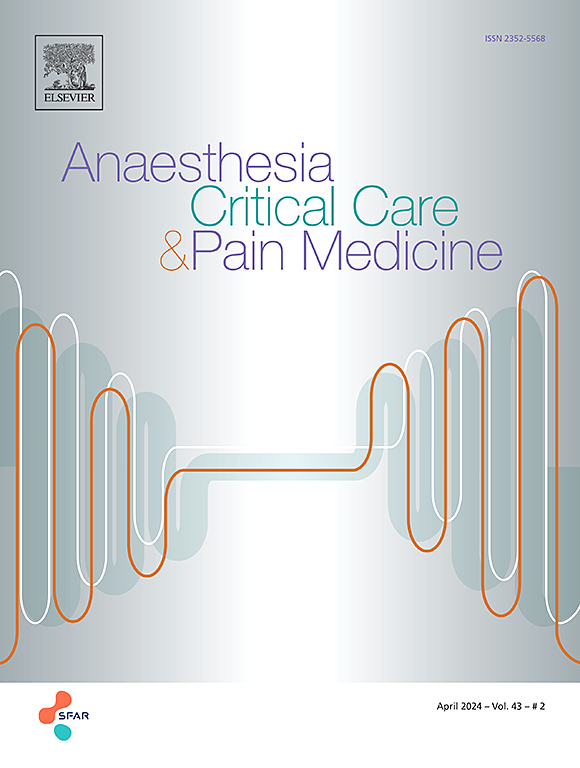输注去甲肾上腺素预防胆道闭锁婴儿开赛门肠造口术肝外置术期间低血压:一项随机对照试验
IF 3.7
3区 医学
Q1 ANESTHESIOLOGY
引用次数: 0
摘要
背景:Kasai门静脉肠造口术中肝外剥术通常伴有深度低血压。本研究旨在评估预防性去甲肾上腺素输注在Kasai门肠造口手术婴儿血压维持中的作用。方法32例拟行开赛门肠造口术的患儿随机分为两组:去甲肾上腺素组:术中预防性输注去甲肾上腺素;对照组:术中预防性输注安慰剂生理盐水。主要终点是肝外置术期间低血压的发生率,定义为平均动脉压(MAP)持续降低≥20%的基线读数,需要释放肝脏。其他结果包括:手术停止和肝脏释放的频率、肝功能变量、动脉血气参数、术中输注液体的总量、心动过缓和高血压的发生率。结果去甲肾上腺素组肝外置术中持续低血压(定义为给予静脉输液和血管加压剂后需要肝脏释放)的发生率为12.5%(2例),对照组为75%(12例),相对危险度(95%置信区间[CI]): 0.17 (0.04 ~ 0.63), p = 0.001。去甲肾上腺素治疗组3例(18.8%)患者使用去甲肾上腺素,对照组13例(81.3%)患者使用去甲肾上腺素,相对危险度(95% CI): 0.23 (0.08 ~ 0.66), p = 0.001。结论在行Kasai门肠造口术的胆道闭锁婴儿中,去甲肾上腺素输注可显著降低肝外置术中需要肝脏释放的持续性严重低血压的发生率。临床试验编号nct05521152。登记URLhttps: / / clinicaltrials.gov /研究/ NCT05521152。本文章由计算机程序翻译,如有差异,请以英文原文为准。
Norepinephrine infusion for preventing hypotension during hepatic exteriorization in Kasai portoenterostomy in infants with biliary atresia: A randomized controlled trial
Background
Hepatic exteriorization during Kasai portoenterostomy is usually associated with profound hypotension. This study aimed to assess the role of prophylactic norepinephrine infusion in maintaining blood pressure in infants undergoing Kasai portoenterostomy operation.
Methods
Thirty-two infants scheduled for Kasai portoenterostomy operation were randomly assigned to one of two groups: Norepinephrine group: this group received prophylactic intraoperative norepinephrine infusion, Control group: this group received placebo saline infusion. The primary outcome was the incidence of hypotension during liver exteriorization, defined as a persistent reduction of the mean arterial pressure (MAP) ≥20% of the baseline reading requiring release of the liver. Other outcomes included: the frequency of stoppage of surgery and release of the liver, liver function variables, arterial blood gases parameters, total volume of intraoperative infused fluids, and incidence of bradycardia and hypertension.
Results
The incidence of persistent hypotension (defined as the need for liver release after administering IV fluid and vasopressor boluses) during liver exteriorization, was 12.5% (2 patients) in the norepinephrine group compared to 75% (12 patients) in the control group, relative risk (95% confidence interval [CI]): 0.17 (0.04−0.63), p = 0.001. Rescue norepinephrine boluses were used in 3 patients (18.8%) in the norepinephrine group compared to 13 patients (81.3%) in the control group, relative risk (95% CI): 0.23 (0.08−0.66), p = 0.001.
Conclusion
Among infants with biliary atresia undergoing Kasai portoenterostomy operation, norepinephrine infusion significantly reduced the incidence of persistent severe hypotension during hepatic exteriorization requiring liver release.
Clinical trial identifier
NCT05521152.
Registration URL
https://clinicaltrials.gov/study/NCT05521152.
求助全文
通过发布文献求助,成功后即可免费获取论文全文。
去求助
来源期刊

Anaesthesia Critical Care & Pain Medicine
ANESTHESIOLOGY-
CiteScore
6.70
自引率
5.50%
发文量
150
审稿时长
18 days
期刊介绍:
Anaesthesia, Critical Care & Pain Medicine (formerly Annales Françaises d''Anesthésie et de Réanimation) publishes in English the highest quality original material, both scientific and clinical, on all aspects of anaesthesia, critical care & pain medicine.
 求助内容:
求助内容: 应助结果提醒方式:
应助结果提醒方式:


